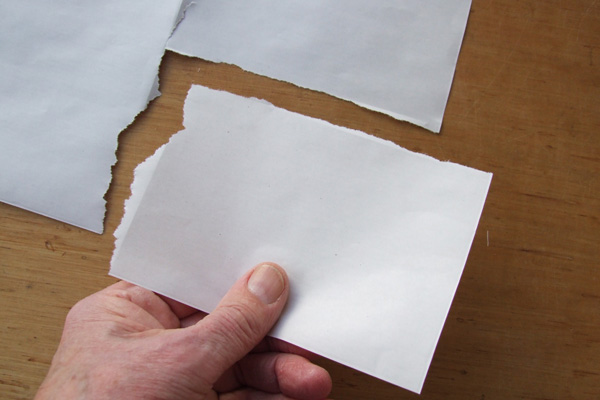
The easier tear is quickly determined by two tears ~
and it follows the grain direction
Knowing the grain direction of paper is essential in all aspects of bookcraft and bookbinding. Here are some explanations to illustrate that comment.

The picture above shows a sheet of office paper that was loosely folded in half, and then half again. Then one quarter of the sheet was torn out. The folds were not heavily creased. The tears, rather than following the route of the creases, took a path dictated by the grain of the paper. As with traffic ~ rivers ~ public opinion ~ even life ~ it is much easier to 'go with the flow' rather than 'than kick against the pricks'.
The tears, in the picture, show a neater tear parallel to the long edge. That tear is running with the grain. The rather more ragged tear, on the shorter edge, is against the grain. The fibres in the paper were trying to change the direction of the tear so that it followed the easier route of splitting with the grain.
Paper will bend and fold more easily along the grain than across it. This is especially pronounced with cards. It can be be very difficult to fold a card across the grain with a neat result. Scoring the card can weaken the grain, such that the fold is easier. Small ~ hand operated ~ machines are available for helping with this. They do so by crushing the fibres of the paper. They are are likely to cost around three-figure sum. For thinner cards a blunt knife and straight edge will do the job. There are small scoring boards that help. (Not all are suitable for 'A' series of papers, since they are calibrated for inches.
It is common practice for office papers to be called 'long grain'. This means that the grain runs parallel with the longer edges. The thumb is holding one of these edges, and the neater tear runs along the grain. The other, wandering, tear is running across the grain.
Another common, but not universal, practice is for A3 sheets to be 'short grain'. Some catalogues assume every sheet is 'long grain except where mentioned'. A comprehensive wholesaler might well stock a brand of paper under two headings 'A3' and 'A3 cross grain'. There may also be difference in price.
It is important for the print trade to know the grain direction since some presses require the paper to be fed in with the grain in one direction. The mechanisms of the press or printer may require the paper to bend around the rollers ~ as in compact desktop laser printers. A different press may wish to encourage a straight path through rollers, for which stiffness is required. It can take a long time to clear out a machine in which a sheet has wrapped itself around a roller. I know this to my cost, after many years in the print trade.
More importantly if a book is being printed the imposition will require folios to be folded with the grain if the book is to open properly.
There are several ways of finding the grain direction in addition to that at the top of this page. We provide illustrations of some other methods.
